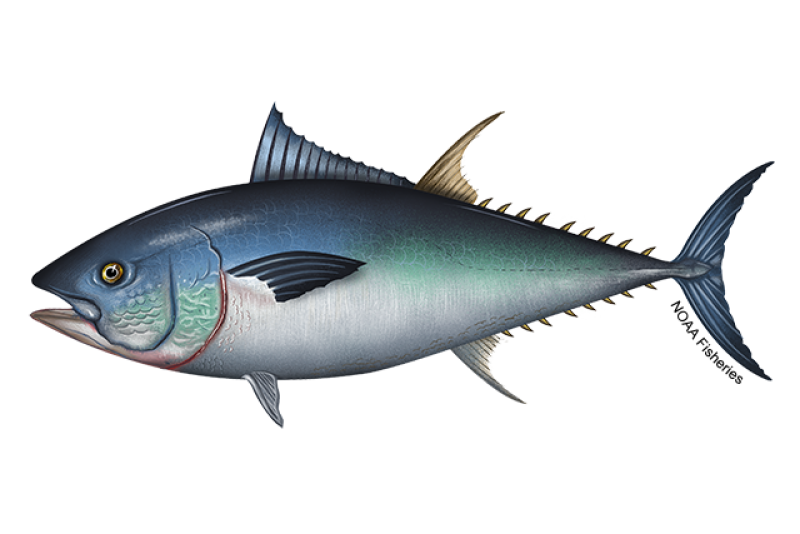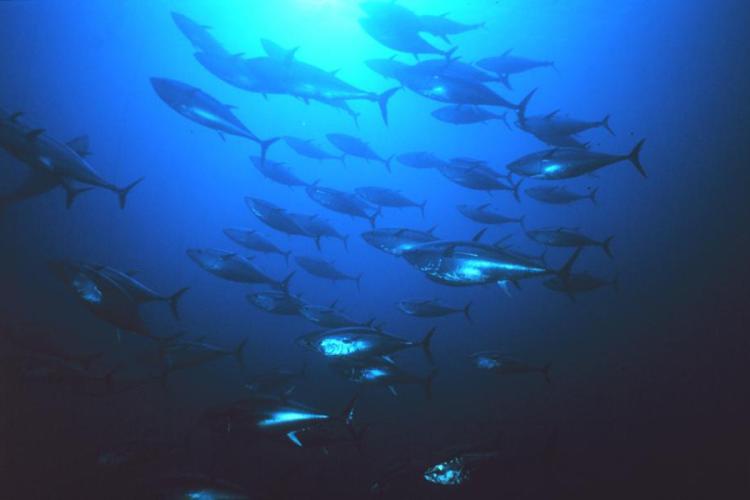Pacific Bluefin Tuna
Although Pacific-wide populations are well below target levels, U.S. wild-caught Pacific bluefin tuna is a smart seafood choice because it is sustainably managed under rebuilding measures that limit harvest by U.S. fishermen.
Pacific Bluefin Tuna

Also Known As
Northern bluefin tuna, Tuna, Bluefin tuna
Quick Facts
Pacific Islands, West Coast
 School of bluefin tuna swimming in dark ocean waters with some light coming in from above." width="750" height="500" />
School of bluefin tuna swimming in dark ocean waters with some light coming in from above." width="750" height="500" />
School of bluefin tuna. Credit: NOAA Fisheries
School of bluefin tuna. Credit: NOAA Fisheries
About the Species
 School of bluefin tuna swimming in dark ocean waters with some light coming in from above." width="750" height="500" />
School of bluefin tuna swimming in dark ocean waters with some light coming in from above." width="750" height="500" />
School of bluefin tuna. Credit: NOAA Fisheries
School of bluefin tuna. Credit: NOAA Fisheries
Although Pacific-wide populations are well below target levels, U.S. wild-caught Pacific bluefin tuna is a smart seafood choice because it is sustainably managed under rebuilding measures that limit harvest by U.S. fishermen.

Population
The stock is overfished, but the fishing rate promotes population growth.

Fishing Rate
Not subject to overfishing.

Habitat Impact
Fishing gear used to catch bluefin tuna rarely contacts the seafloor so habitat impacts are minimal.

Bycatch
Regulations are in place to minimize bycatch.
Population Status
- According to the 2022 stock assessment, Pacific bluefin tuna is overfished, but not subject to overfishing. Summary stock assessment information can be found on Stock SMART.
- NOAA Fisheries first determined the Pacific bluefin tuna stock to be overfished in 2013. The 2022 assessment completed by the International Scientific Committee for Tuna and Tuna-Like Species in the North Pacific Ocean found the stock is still overfished, but stock size has significantly increased.
Appearance
- Pacific bluefin tuna have black or dark blue dorsal sides, with a grayish-green iridescence.
- Their bellies are dotted with silver or gray spots or bands.
- They have a series of small yellow fins, edged in black, running from the second dorsal fin to the tail.
- A distinguishing characteristic of Pacific bluefin tuna is that the tips of the pectoral fins do not reach the front of the second dorsal fin.
- They have relatively small eyes compared to other species of tuna.
Biology
- Pacific bluefin tunas reach maturity at approximately 5 years of age and can live up to 26 years, although the average lifespan is about 15 years.
- Adults are approximately 1.5 meters (4 feet 11 inches) long and weigh about 60 kilograms (130 pounds).
- The maximum reported length and weight for Pacific bluefin tuna is 3 meters (9.8 feet) in length and 450 kilograms (990 pounds).
- Pacific bluefin tunas are predatory and mainly eat squids and fish, such as sardines and anchovies, saury, herring, pompanos, mackerel, hake, other tunas, and occasionally red crabs and krill.
Where They Live
Range
- Most of the U.S. catch of Pacific bluefin tuna is within about 100 nautical miles of the California coast.
Habitat
- Bluefin tuna are highly migratory and travel long distances throughout the Pacific Ocean.
- They are found mostly in temperate ocean waters but also in the tropics and cooler coastal regions.
- Of the tunas, Pacific bluefin tuna have the largest geographic range.
- Tagging studies have revealed that some bluefin spend their entire lives in the Western Pacific Ocean, while others migrate to the Eastern Pacific Ocean. The trans-Pacific journey can take as little as 55 days.
Fishery Management
- Management of highly migratory species, such as Pacific bluefin tuna, is complicated because they migrate thousands of miles across oceans and international borders and are fished by many nations.
- Effective conservation and management of these resources requires international cooperation as well as strong domestic management. The United States continues to encourage harvest levels internationally that rebuild the population.
- Two international organizations, the Inter-American Tropical Tuna Commission (IATTC) and the Western and Central Pacific Fisheries Commission (WCPFC) coordinate management of this fishery across jurisdictions of member and cooperating nations. Working with the U.S. Department of State, NOAA Fisheries implements the IATTC and WCPFC conservation and management measures as regulations for U.S. fleets.
- NOAA Fisheries and the Pacific Fishery Management Council and the Western Pacific Fishery Management Council manage this fishery on the West Coast and in the Pacific Islands under the Fishery Management Plan for U.S. West Coast Fisheries for Highly Migratory Species and the Fishery Ecosystem Plan for the Pelagic Fisheries of the Western Pacific, respectively.
- NOAA Fisheries works with the councils to provide recommendations to the Commissions and implement domestic regulations under the authority of the Magnuson-Stevens Fishery Conservation and Management Act (MSA).
- The councils provide advice to NOAA Fisheries and the Department of State, so that the councils’ interests are represented in international negotiations.
- Councils will also develop recommendations for domestic regulations to address the relative impact on the stock by U.S. vessels.
Harvest


 School of bluefin tuna swimming in dark ocean waters with some light coming in from above." width="750" height="500" />
School of bluefin tuna swimming in dark ocean waters with some light coming in from above." width="750" height="500" /> School of bluefin tuna swimming in dark ocean waters with some light coming in from above." width="750" height="500" />
School of bluefin tuna swimming in dark ocean waters with some light coming in from above." width="750" height="500" />


